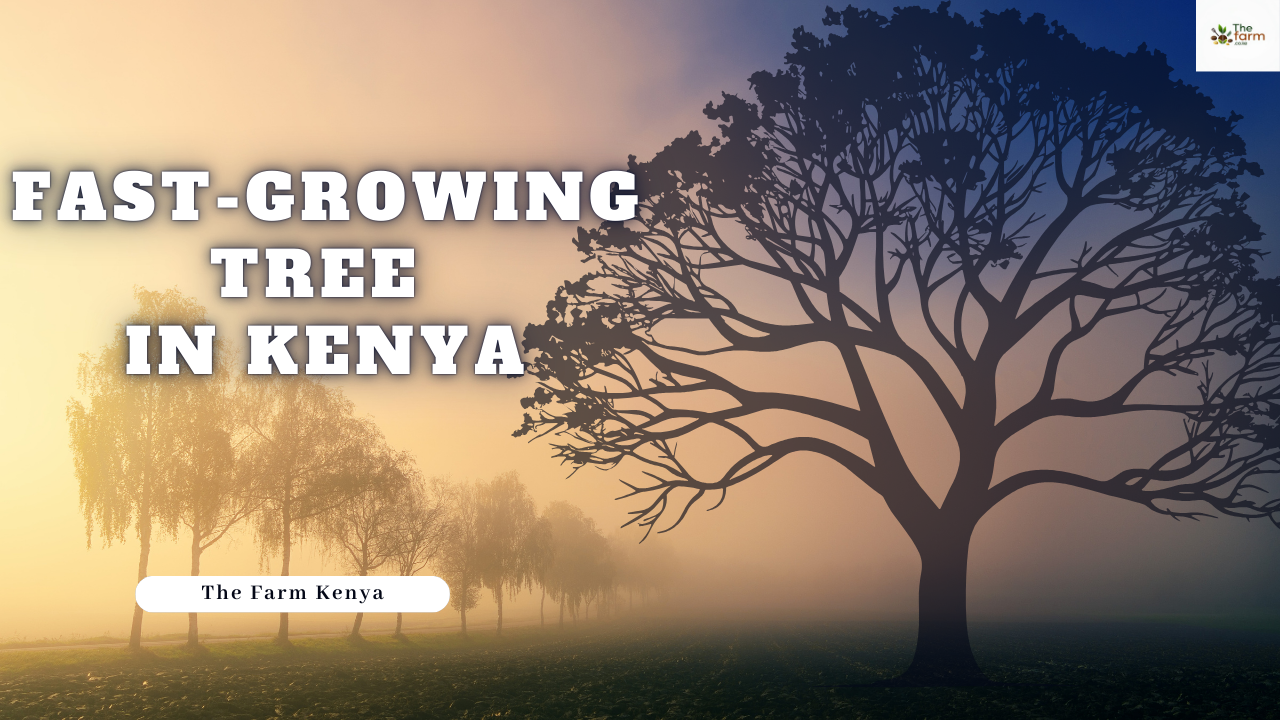Top 10 Fast Growing Trees in Kenya For Shade and Profit

Let’s be real for a second—the thought of waiting 25 years for a tree to mature so it can provide some decent shade or start making money? That’s a hard no for most Kenyans right now. In a country grappling with high costs of living and economic uncertainty, everyone wants an investment with fast returns. Nobody has the time (or patience) to wait for decades. So if you’re scratching your head wondering which fast growing trees in Kenya can give you shade and money without the long wait—you’ve landed in the right place.
In this guide, we’ll walk you through 10 fast growing trees in Kenya that not only provide much-needed shade but also bring in good profits. Whether you’re living in arid zones, fertile highlands, or peri-urban spaces—there’s something here for everyone. You’ll also get to know what makes trees grow faster, and maybe even discover what’s the easiest tree to grow in your region.
Top 10 Fast Growing Trees in Kenya
1. Melia volkensii (Mukau) – Ideal for Eastern Kenya
Best Regions: Kitui, Makueni, Machakos
Use: Profitable
Benefits: Drought-tolerant, used for timber, and matures in 8–10 years.
Mukau is a fast growing tree in Kenya, especially suitable for semi-arid areas like Eastern Province. It thrives in low-rainfall regions and is increasingly becoming a top choice for commercial timber farming. It’s resistant to termites, has high market value, and does well with minimal watering. What makes trees grow faster in these areas is drought resistance—and Mukau excels here.
2. Grevillea robusta – Popular in Central Kenya
Best Regions: Nyeri, Murang’a, Kiambu
Use: Shade and profit
Benefits: Used in agroforestry, provides quality timber, fast canopy.
If you’re wondering what’s the easiest tree to grow in Central Kenya, Grevillea is another Fast Growing Trees in Kenya. It grows quickly, doesn’t compete with crops, and provides excellent shade. Farmers love it for boundary planting and its timber fetches good prices locally.
3. Eucalyptus grandis – Common in Western Kenya
Best Regions: Kakamega, Bungoma, Vihiga
Use: Profitable
Benefits: Used in construction, poles, and pulp industries.
This is one of the most fast growing trees in Kenya, maturing in 5–7 years. Eucalyptus is loved for its straight trunk and multiple uses in the commercial sector. However, it needs careful management due to its high water uptake.
4. Moringa oleifera – Thrives in Coast and North Eastern Kenya
Best Regions: Tana River, Garissa, Kilifi
Use: Profit and health
Benefits: Leaves and seeds are medicinal and highly nutritious.
Moringa is a miracle tree. Not only does it grow ridiculously fast (as in visible growth in a matter of weeks), but it’s also drought-resistant. Its leaves, pods, and seeds are used for food, oil extraction, and medicine. It’s also one of the easiest trees to grow even in poor soils.
5. Markhamia lutea – Great for Nairobi and Urban Areas
Best Regions: Nairobi, Kajiado, Kiambu
Use: Shade
Benefits: Ornamental, attracts birds, and perfect for beautification.
Markhamia is a favorite among urban dwellers because of its beautiful flowers and rapid canopy development. It’s ideal for creating green spaces in estates and schools. Plus, it’s easy to manage and gives fast results in terms of coverage.
6. Casuarina equisetifolia – Grows well at the Coast
Best Regions: Mombasa, Kwale, Lamu
Use: Profit and erosion control
Benefits: Strong timber, windbreaks, and coastal soil stabilization.
Casuarina is among the fast growing trees in Kenya that do wonders in sandy soils. It thrives under salty conditions, making it perfect for coastal counties. Its wood is dense and good for construction and fuel.
7. Sesbania sesban – Best for Rift Valley
Best Regions: Nakuru, Baringo, Kericho
Use: Shade and soil improvement
Benefits: Nitrogen-fixing, quick-growing fodder tree.
This multipurpose tree is not just fast-growing—it’s also a soil fixer. Farmers in Rift Valley use it in intercropping systems. In just 6–12 months, it forms a healthy canopy and enriches the soil.
8. Leucaena leucocephala – Best for Nyanza Region
Best Regions: Kisii, Homa Bay, Migori
Use: Fodder and shade
Benefits: Improves soil, great for livestock feed.
This is another fast growing tree in Kenya, particularly great for mixed farming systems. It provides excellent shade and is ideal for small-scale farmers keeping livestock. The leaves are protein-rich and can be harvested often.
9. Croton megalocarpus – Ideal for Mount Kenya Region
Best Regions: Meru, Embu, Tharaka Nithi
Use: Shade and biofuel
Benefits: Eco-friendly, fast-growing, minimal maintenance.
This indigenous tree is gaining popularity due to its fast growth and utility in green energy. Its seeds can be used to produce biofuel. Plus, it offers excellent shade with broad leaves and rapid trunk development.
10. Terminalia brownii – Thrives in Northern Kenya
Best Regions: Turkana, Marsabit, Isiolo
Use: Profit and resilience
Benefits: Windbreak, durable wood, medicinal uses.
This is one of the toughest yet fast growing trees in Kenya, making it ideal for arid and semi-arid lands. It offers shade, wind protection, and its wood is valuable for carpentry. It grows faster than you’d expect in dry areas due to its adaptability.
11. Calliandra calothyrsus – Great for Kapsabet and Nandi Hills
Best Regions: Kapsabet, Nandi, Eldoret
Use: Fodder and soil improvement
Benefits: Excellent for livestock feed, fixes nitrogen in soil, and provides quick biomass.
Calliandra is a farmer’s dream in highland zones like Kapsabet. It grows fast, enriches the soil, and its leaves are rich in protein—making it a top pick for dairy farmers. It also helps in reducing soil erosion and can be pruned regularly for biomass. So yes, if you’re in Nandi County and wondering what’s the easiest tree to grow, this one’s a sure bet!
12. Bamboo (Dendrocalamus asper) – Thrives in Central and Western Kenya
Best Regions: Nyandarua, Kericho, Kakamega
Use: Shade and profit
Benefits: Used for furniture, construction, eco-friendly straws, and more.
Though technically a grass, bamboo is one of the fast growing trees in Kenya (yes, we’re bending the rules a little). It matures in 3–4 years and has massive commercial potential. In eco-conscious markets, bamboo products are in high demand. Plus, it forms thick canopies—perfect for shade.
13. Neem (Azadirachta indica) – Perfect for Dry Areas
Best Regions: Baringo, Isiolo, Garissa
Use: Shade and medicinal profit
Benefits: Treats pests naturally, provides medicinal leaves and oil, grows in poor soils.
Neem is resilient and what makes trees grow faster in dry climates often comes down to adaptability—and this tree thrives where others fail. Its medicinal value is huge, and it also helps control pests naturally in your compound or farm.
14. Jacaranda mimosifolia – Beautiful Tree for Urban Counties
Best Regions: Nairobi, Nakuru, Kisumu
Use: Shade and ornamental
Benefits: Rapid canopy, beautiful purple flowers, boosts property value.
Jacaranda isn’t just fast—it’s gorgeous! Its vibrant flowers make it a landscaping favorite in cities like Nairobi and Nakuru. It’s ideal for anyone who wants fast growing trees in Kenya that turn heads and offer cool shade in hot weather.
15. Paulownia elongata – High-value Timber Tree for Highlands
Best Regions: Nyeri, Kericho, Nyahururu
Use: Profit
Benefits: Grows up to 3m per year, produces lightweight timber, used in music instruments, boats, and luxury furniture.
This is a relatively new but incredibly promising entry into the Kenyan forestry scene. With proper care, Paulownia grows at lightning speed and its wood is highly valuable internationally. Its leaves are also used as fodder, making it multifunctional.
Conclusion
Kenya’s diversity in climate and geography opens the door to a range of fast growing trees in Kenya—each suited to a particular region, purpose, and benefit. Whether you’re looking for shade to cool your homestead or eyeing a profitable timber venture, there’s a tree on this list that can serve your needs and grow in record time.
The secret to success? Understand what makes trees grow faster—from soil quality to choosing species adapted to your county’s climate. So next time someone asks what’s the easiest tree to grow in Kenya, you’ll not only have an answer—you’ll have ten. Get planting and let your trees do the talking (and profiting)!

